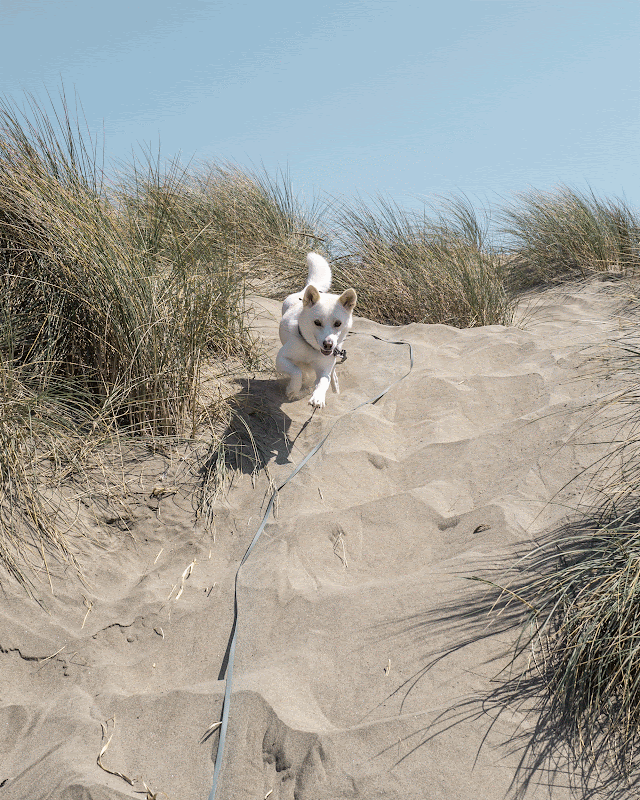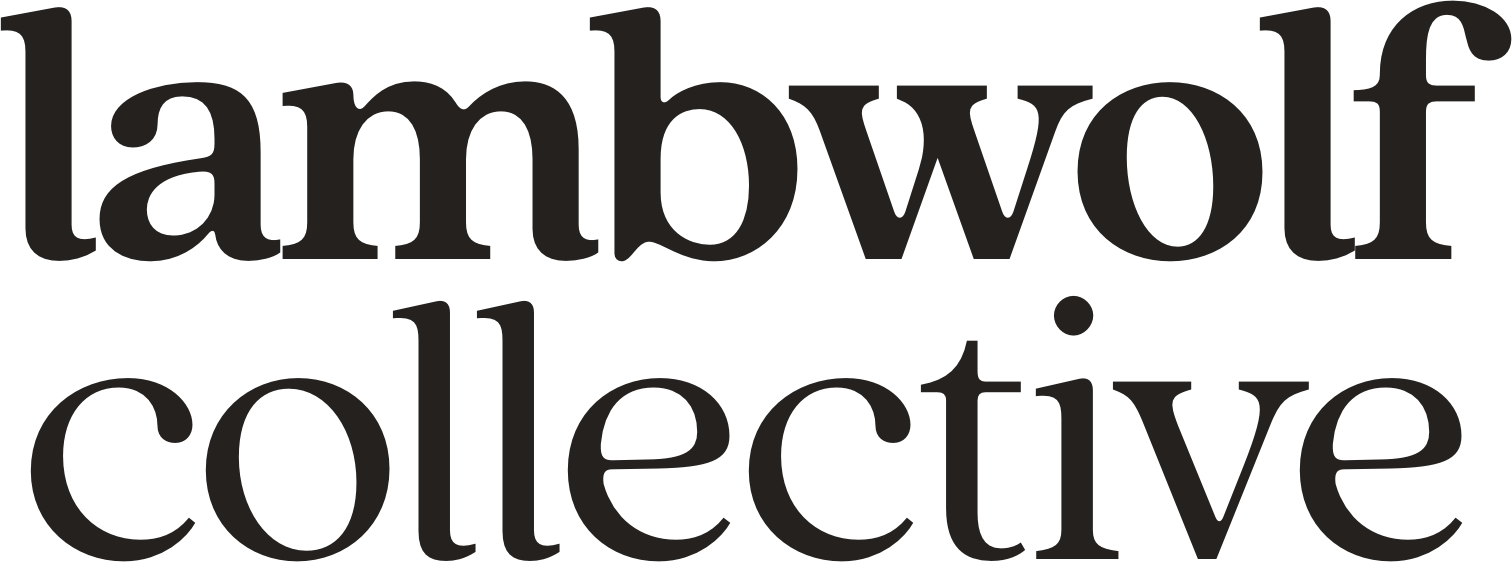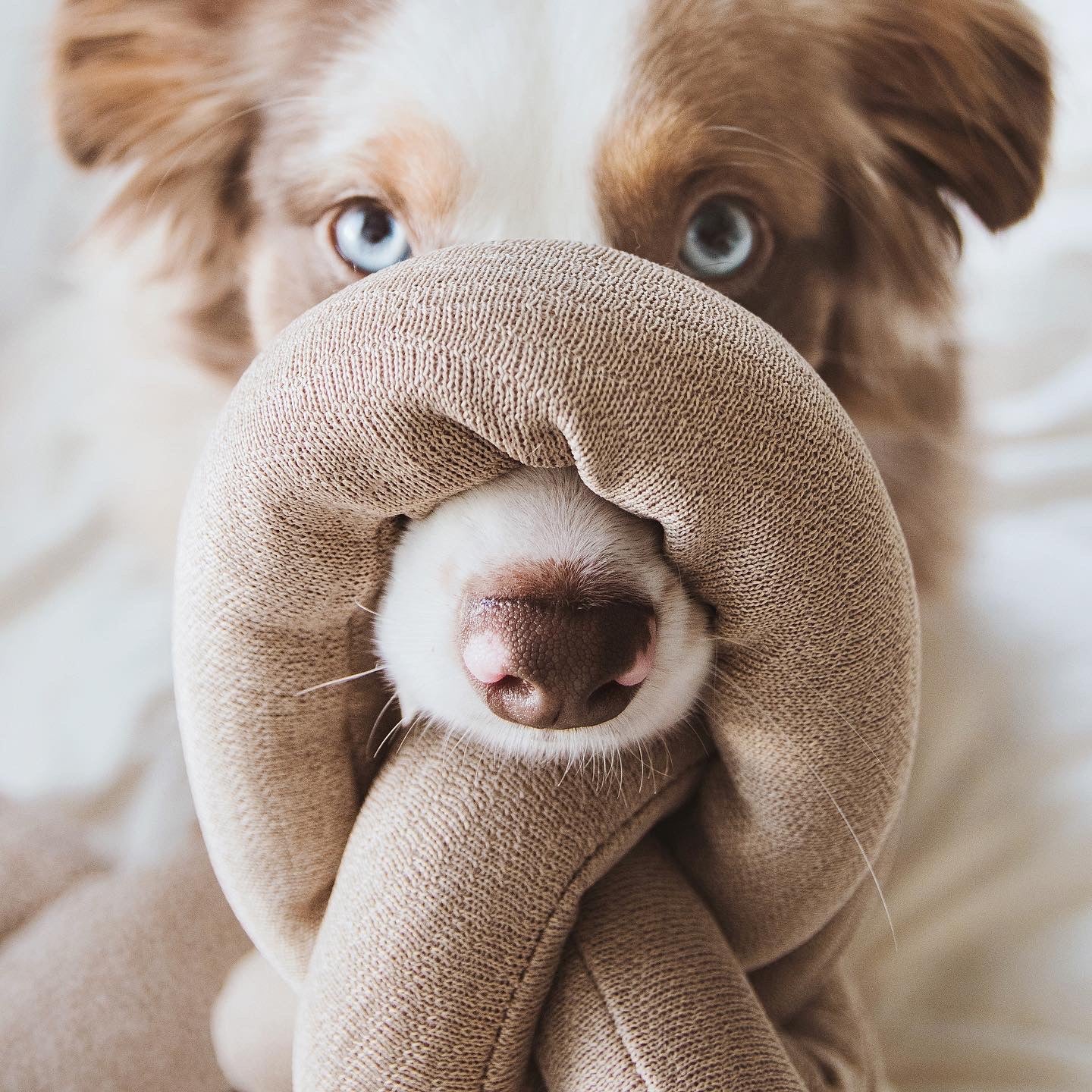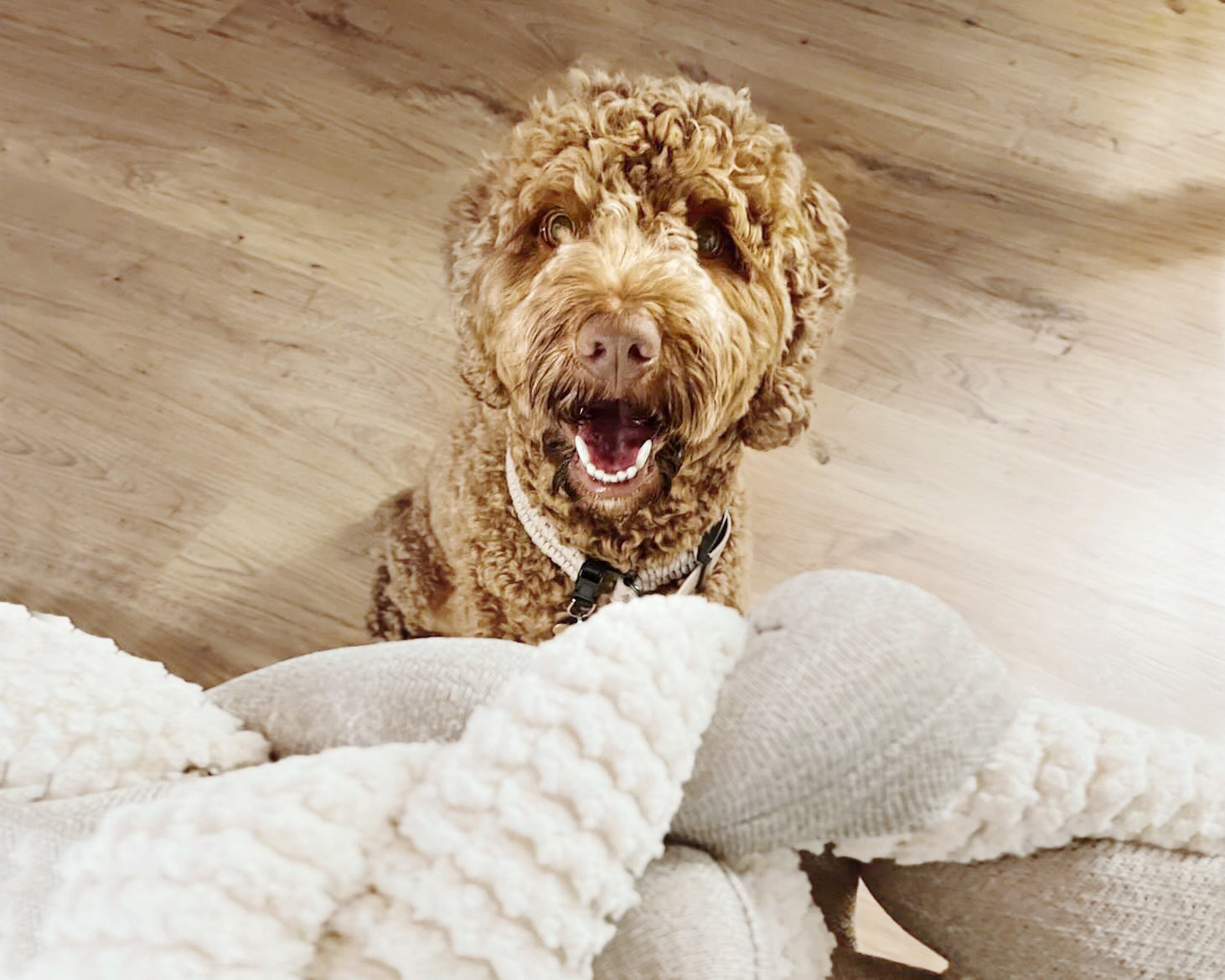
Connecting through a Long Lead
Meeting our beautiful, complex, flight-risk dog
My partner and I weren’t able to formally meet Julie prior to adopting her. However, our local Bay Area rescuer put us in touch with Julie’s Korean rescue organization to ask questions and learn more about Julie. I was impressed at how well they documented Julie’s past year in their rescue program and life in South Korea. I watched countless cute videos, scrolled through her hashtag, and read her different fosters’ blog posts. Her rescuer spoke highly of all the good parts — how Julie would roll on her belly for pets. But they also detailed the challenges — how she would tunnel vision on prey and has run away several times to chase them.
In one particular video and blog post, I watched Julie happily trotting off-leash alongside her foster parent in one minute, and then bolting off into the forest to chase a family of deer in the next. The foster parent frantically yelled out Julie’s name to call her back, but she was long gone. Not all runaway dogs get second or third chances, but Julie was a lucky one to be found and reunited with her foster parent by the end of the day.
Although my heart dropped when I watched the video, I was grateful for the extensive documentation. It gave me realistic expectations for our sweet yet prey-driven, reserved yet brave, loyal yet independent, primitive, complex, and beautiful dog.
Training for our best, collective lifestyle
When we adopted Julie, we had our fair share of miscommunications. First, there was an apparent language barrier between us. We quickly realized that Julie didn’t understand English cues like “sit” and responded much better to the Korean equivalent “앉아.” Additionally, we had a species communication barrier as well. My partner and I were first-time dog parents. We didn’t understand how to read dog body language, nor communicate effectively with a dog.
We partnered with a private obedience trainer who could help us establish strong relationships with Julie and build clear communication. And while obedience was our training foundation, we made sure to never lose sight that our goals were so much more. Our aspirations in training were about giving Julie more freedoms, protecting her well-being and safety, and our collective peace of mind.
We dreamed of living a life alongside Julie where we could include her on all our adventures, both urban and wild. We’d be able to help Julie confidently navigate our modern world of city sidewalks, construction sounds, and patio dining. Simultaneously, it was important for us to allow Julie to “just be a dog.” This meant giving Julie the freedom to explore nature and engage her biological senses while still prioritizing her safety as a prey-driven, flight-risk dog. Off-leash freedom was the absolute dream, but we knew it would take consistent work, a strong bond to re-engage her focus from hyper-fixations, a solid recall, a clear communication system, and much more.
Discovering the long lead
The beginning of our training journey challenged us to rapidly grow as a team. We made tweaks to our lifestyle, shifted our mindsets, and absorbed so much new information. We learned about how training methods could be paired with different tools such as food, collars, and leashes, and how these tools can aid us in achieving our goals.
Midway through our program, our trainer introduced the long lead and taught us how to use the leash to its fullest training potential. Most walking leashes we previously used were no longer than six feet and designed to keep Julie close to us. But the long lead we used for training was a whole lot of leash at twenty feet long. Through my personal experience of handling the long lead, it quickly became a favorite tool with the Nomad as our go-to.
First and foremost, the long lead was our safety tool. It was perfect for managing a flight-risk dog like Julie when she did not have a reliable recall command. Julie would not be able to run away, and we could keep her and those around us safe.
Second, the long lead was valuable as a directional communication tool. Early in our training, there was a lot of physical handling of the leash to teach and reinforce Julie’s obedience with place training, stays, and recall. Through gentle guidance of the leash, we could clearly communicate and demonstrate what success looked like for her. We taught her that “come” meant moving in the direction closer to us and not away. In addition, if Julie found herself to be confused or lost midway through a command, we were able to guide her way back with clarity and remind her of the correct positions and expectations.
Lastly, the long lead was a transitional training tool that started to give Julie the freedoms to explore, gain distance from her handlers, and make her own choices. When Julie demonstrated that she was becoming reliable in off-leash training and understood her expectations, we would drop the leash and let it drag. How she made decisions and used her freedom were all her own. If at any point Julie’s obedience regressed, we would go back to the basics. We would then pick up the leash to give Julie more guidance until she was ready to progress again.
Personal takeaways for using the long lead for training
Training became integrated in our lifestyle. It’s no longer something that feels like a chore nor something we have to find time for. We schedule training around Julie’s meal times, carry a long lead almost everywhere we go, and implement recall practice in our daily walks.
With so much practice and many mistakes, I reflect on my biggest takeaways while training and handling a long lead.
-
The right tools matter.
Bringing a long lead on walks or adventures used to be a hassle, so it was important to find a leash we actually loved using. We’ve tried multiple kinds of long leads and have been guilty of leaving them behind at home or in the car, that is, until we discovered Lambwolf’s 20’ long line. The Nomad solved so many issues we had with other long leads that were bulky to carry, created a lot of drag for Julie, and an eye sore to me. However, the Nomad is compact enough to toss in my purse or pocket, lightweight enough for Julie to simulate off-leash freedom, and looked beautiful in all photos. We love our long line so much that it quickly became the leash that we grab for first and use the most.
-
Using tools won’t train the dog. It’s about *how* we use them.
Prior to working with a trainer, we made the mistake of repeatedly yelling “Come, Julie. Come! Come!” while Julie mostly ignored us. We would wave a treat toward her face but the leash sat idly on the ground. In this scenario, clipping a long lead to a collar wasn’t going to miraculously teach Julie how to recall. Repeatedly calling “come” without further guidance or accountability was teaching Julie that the cue did not have significant value or meaning. Unconsciously, we were poisoning the command. We also did not realize that we were setting up Julie to fail and dwell in confusion, especially when she did not understand the cue. Tools are just tools. They won’t produce progress, and can sometimes harm, if they are not paired with the best training methods for the dog. Since our training is inspired by a philosophy that clarity is kindness, it meant that we needed to physically and gently guide the leash to teach Julie what success looked like. Through this process of handling the long lead with intention and clear communication, Julie learned a reliable recall.
-
Trust, don’t rush, the process.
It’s very tempting, but many people get rid of the leash early in (or even before) their training. This is something we, along with Julie’s previous handlers before us, were completely guilty of. Julie’s previous foster parent allowed Julie to walk without a leash and quickly learned the consequences of a lost dog. We also dropped the leash and indirectly taught Julie an unreliable recall. Since off-leash freedom was one of our big goals, it was difficult to not want to rush into it. But we needed to have patience in discovering what Julie was capable of handling and not, and taking all the small steps to set Julie up for success. Progress often felt incremental, but the results were transformative.
-
There’s no shame going back to the basics.
Progress in training isn’t always linear either. Every once in a while, we would regress and need to be flexible. On most days, Julie has great engagement with me and earns her off-leash freedoms. On other days, Julie would be too distracted or hyper-focused on something else, so we’d keep the long lead on. We try not to place any blame or shame as we all have our off days. Instead, we meet Julie where she’s at and give her what she’s capable of handling until we are ready to progress again. Whenever we’re in doubt, we can always fall back on our training tools and foundations.
-
End on a positive note.
Ideally, we’d like to keep our training sessions a positive experience for Julie. However, the reality is that we are often faced with challenges and setbacks. If we don’t end on a positive note, we risk losing Julie’s trust in us, her environments, and possibly even her tools like the long lead. We can’t always control Julie’s training sessions and environments, but we can make sure that we end our training sessions, activities, and adventures on a positive note so that she’ll come back for more day after day.
Meeting Julie where she’s at today
A part of Julie will always be that dog that ran away to chase the family of deer into the forest. But we have gained confidence in our handling skills, relationship with Julie, and clear communication system to be able to grant her with increasing off-leash freedoms. On our best days, Julie earns her freedom to explore off-leash in safe environments. On most days, we take our 20’ Nomad out on our neighborhood walk to effortlessly transition between a structured walk and freedom.
Although we graduated from our private obedience training program, we are constantly pushing ourselves to reach the lifestyle goals we defined earlier and more. We are proud of how far we’ve come as a team, enjoy the life we’ve worked hard to build together, and look forward to discovering new outlets and activities to fulfill Julie’s biological needs as a remarkable, primitive dog.
Please feel free to head on over to our Instagram, where you can keep up with our training progress and exploration into the off-leash dog sport of agility.
Treats and love ✌️,
Francesca + Julie @treasuredjulie
*Disclaimer: I am not a professional trainer and only speak from a personal experience. The best methods that worked for us may not be the best methods for you and your dogs. Please consult with a professional trainer for your individualized training plans.



